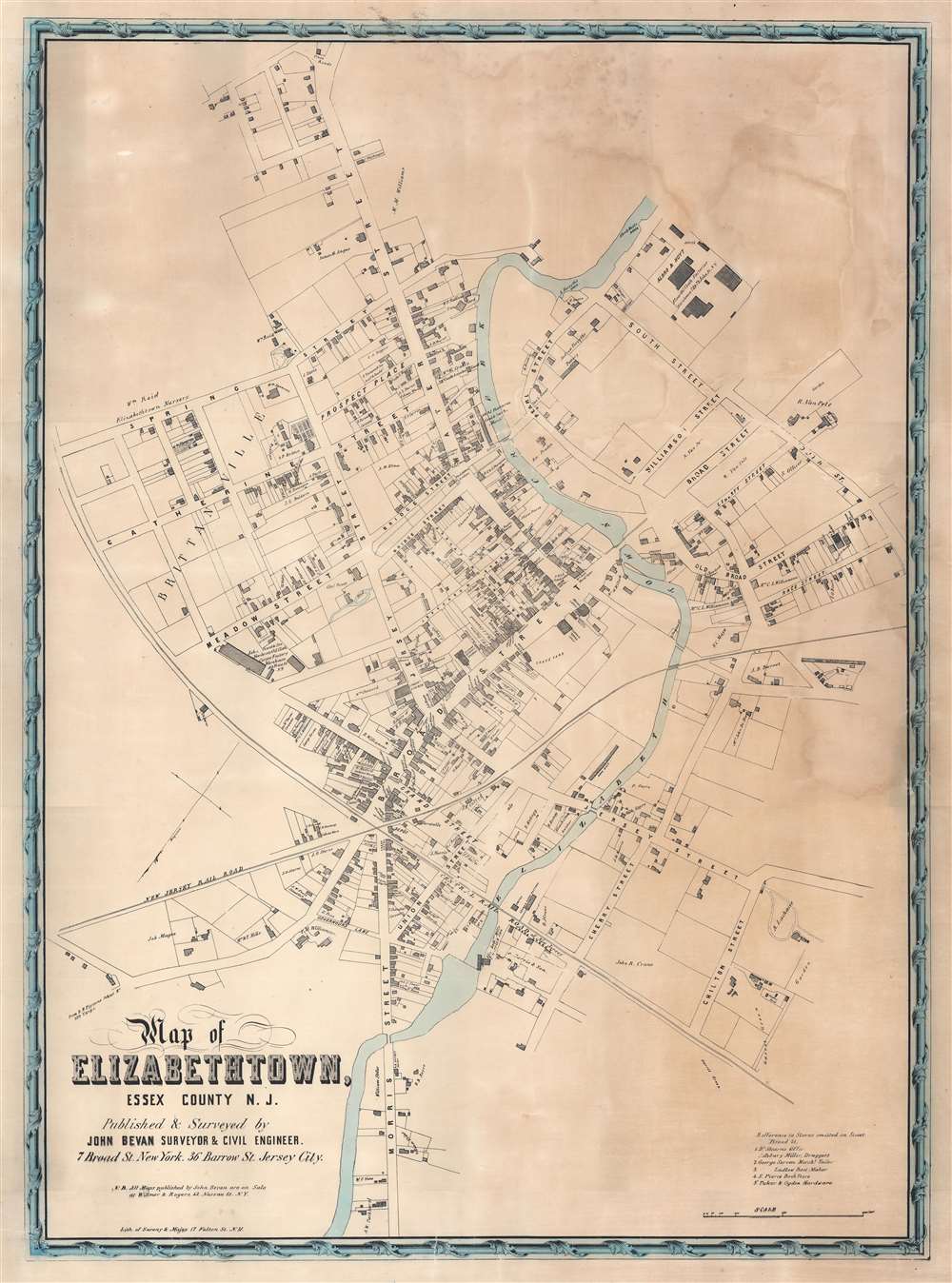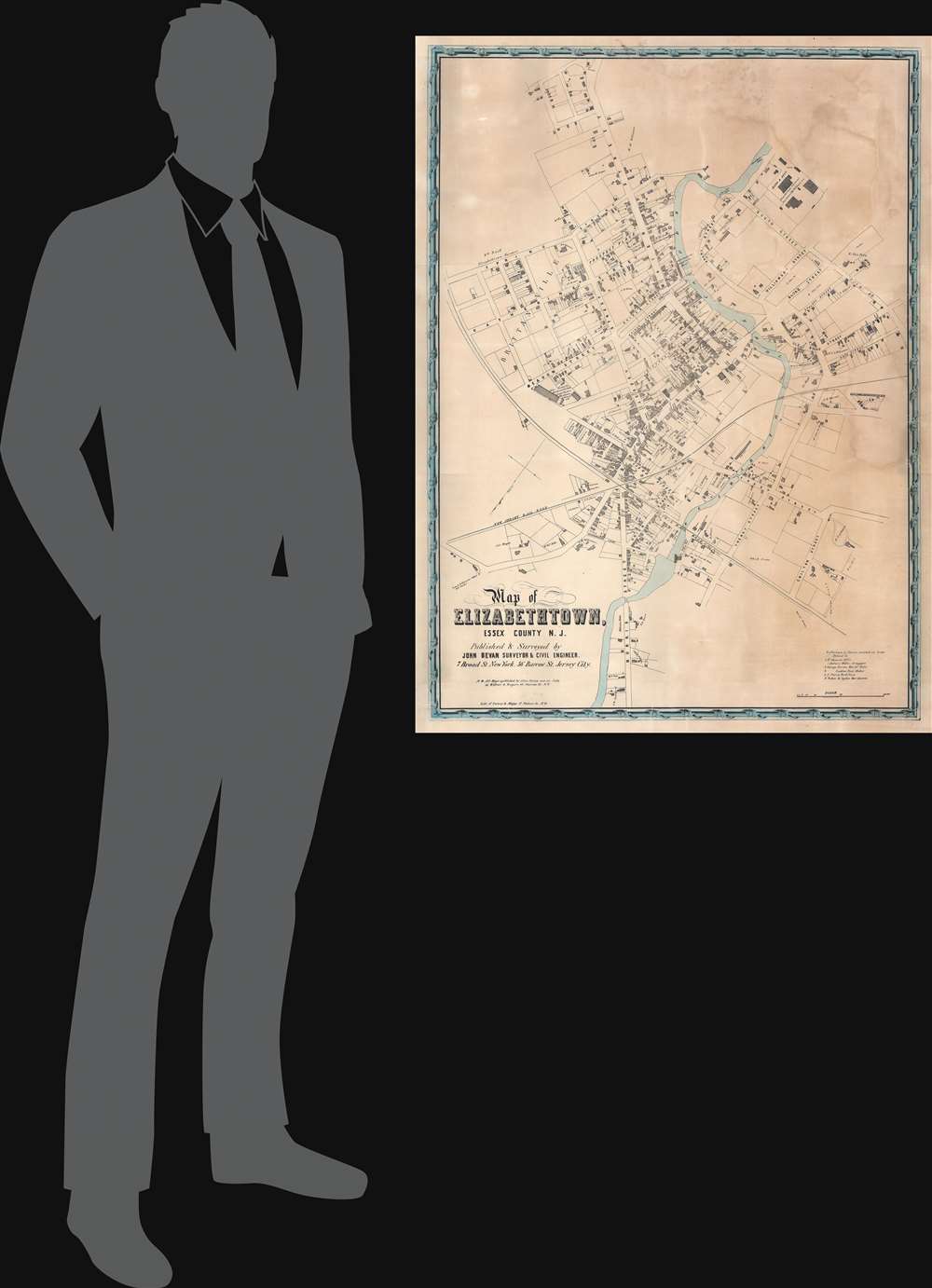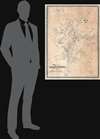This item has been sold, but you can get on the Waitlist to be notified if another example becomes available, or purchase a digital scan.
1851 Bevan Wall City Plan or Map of Elizabethtown (Elizabeth), New Jersey
Elizabethtown-bevan-1851
Title
1851 (undated) 39.75 x 28.75 in (100.965 x 73.025 cm) 1 : 2400
Description
Publication History and Census
This map was surveyed and published by John Bevan and lithographed by Sarony and Major c. 1851. We note a single cataloged example which is part of the collection at Princeton University. We have followed Princeton's proposed date for dating this piece.CartographerS
John Bevan (1817 - 18xx) was an English American civil engineer and surveyor. Bevan was born in England. It is unclear when Bevan arrived in the United States, but by as early as 1851 he was working as a surveyor and civil engineer in New York and New Jersey creating maps of towns. According to the 1870 U.S. census, he was living in New York and was an American citizen. Very little detail is known about Bevan's life and work. From census data we can deduce that he was married at least one, but most likely twice based on the age of his eleven children. Gertrude, likely his second wife, was thirteen years his junior. More by this mapmaker...
Napoleon Sarony (March 9, 1821 - November 9, 1896) was a dashingly handsome Canadian-American lithographer and publisher active in New York in the mid to late 19th century. Sarony was born in Quebec and emigrated to New York City in 1835. He apprenticed under Henry Robinson (fl. 1830/33 - 1850) before working as a lithograph artist for Nathaniel Currier (1813 - 1888). In 1846, he partnered with Currier's apprentice lithographer Henry B. Major to establish the firm of 'Sarony and Major.' From offices at 117 Futon Street, they published under this imprint until roughly 1853, when Sarony split off on his own under the imprint 'Sarony and Co.', still at 117 Fulton. At the time 'and Co.' probably meant Joseph Fairchild Knapp (1832 - 1891), Sarony's apprentice, and Richard C. Major, possibly Henry Major's son. In 1857, a new imprint was established as 'Sarony, Major and Knapp'. According to an advertisement in the New York Times (Feb 16, 1864), Sarony had invested in the business at founding, but was not an active partner, possibly because he was traveling in Europe. It is unclear why Sarony's name was maintained, possibly to capitalize on his fame, as a honorific, or possibly because he owned a major stake. They published under this imprint until 1863, becoming a major concern at 449 Broadway. Sarony's name was formally removed from the partnership in 1863. At the time he was traveling in Europe, mastering the most advanced color lithography and photographic techniques. He is known to have worked in France, Germany, and England. He returned to New York in the 1860s, establishing a photography company at 37 Union Square that became famous for its portraits of late-19th-century American theater icons. In 1891, Sarony, hoping to capitalize on Sarah Bernhardt's fame as 'Cleopatra', paid the stage actress 1,500 USD to sit for a photo session, the modern-day equivalent of 20,000 USD - suggesting a highly prosperous business. His son, Otto Sarony (1850–1903), continued the family business as a theater and film star photographer. As an aside, Sarony's second wife, Louie Sarony, was a known eccentric who would reportedly dress in elaborate rented costumes to walk around Washington Square each afternoon. Learn More...
Henry Broughman Major (February 17, 1820 - August 28, 1887) was an American lithographer based in New York in the middle to late 19th century. Major was born in Frome, England and emigrated to the United States in 1834. He apprenticed under Nathaniel Currier (1813 - 1888), befriending Currier lithographer Napoleon Sarony (1821 - 1896). Major worked briefly on his own, or perhaps with his cousin James Parsons Major, from 1845 - 1846 at 10 Watts Street. In 1846 he joined Sarony to found 'Sarony and Major', based at 117 Fulton Street, New York. Henry Major left the firm in 1853 for unknown reasons. At this time, a relative, possibly his son, Richard C. Major, continued to work with Sarony and Joseph Fairchild Knapp (1832 - 1891), creating the firm 'Sarony, Major and Knapp' (1857 - 1863). Learn More...




